overheating Acura NSX 2017 Owner's Manual
[x] Cancel search | Manufacturer: ACURA, Model Year: 2017, Model line: NSX, Model: Acura NSX 2017Pages: 473, PDF Size: 16.01 MB
Page 3 of 473
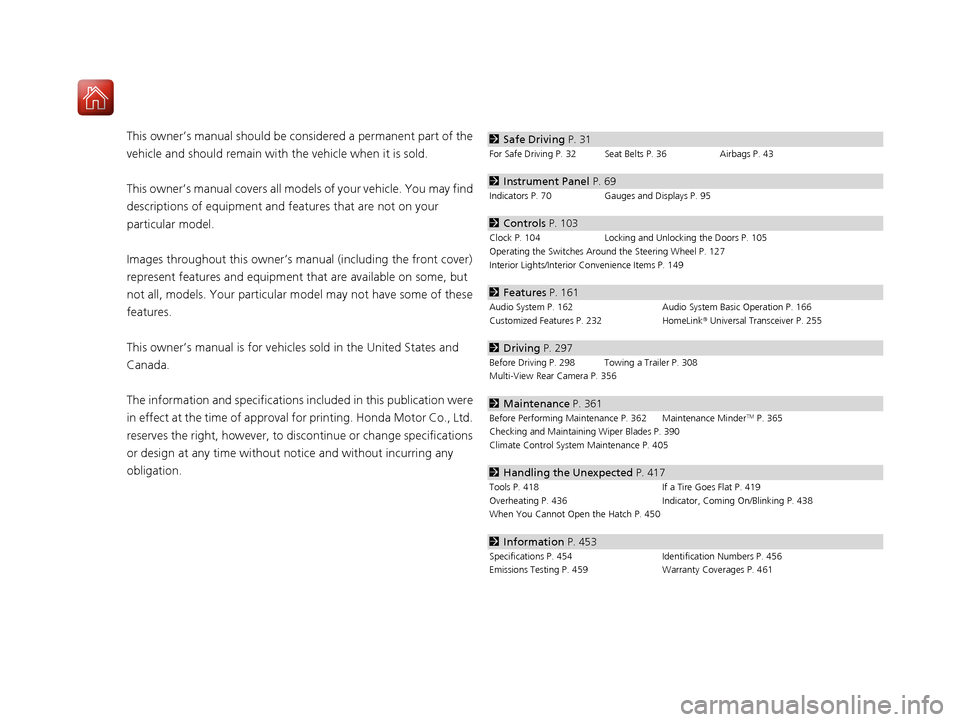
Contents
This owner’s manual should be considered a permanent part of the
vehicle and should remain with the vehicle when it is sold.
This owner’s manual covers all models of your vehicle. You may find
descriptions of equipment and features that are not on your
particular model.
Images throughout this owner’s manual (including the front cover)
represent features and equipment that are available on some, but
not all, models. Your particular mo del may not have some of these
features.
This owner’s manual is for vehicles sold in the United States and
Canada.
The information and specifications in cluded in this publication were
in effect at the time of approval for printing. Honda Motor Co., Ltd.
reserves the right, however, to discontinue or change specifications
or design at any time without notice and without incurring any
obligation.2 Safe Driving P. 31
For Safe Driving P. 32 Seat Belts P. 36 Airbags P. 43
2Instrument Panel P. 69
Indicators P. 70 Gauges and Displays P. 95
2Controls P. 103
Clock P. 104 Locking and Unlocking the Doors P. 105
Operating the Switches Around the Steering Wheel P. 127
Interior Lights/Interior Convenience Items P. 149
2 Features P. 161
Audio System P. 162 Audio System Basic Operation P. 166
Customized Features P. 232 HomeLink® Universal Transceiver P. 255
2 Driving P. 297
Before Driving P. 298 Towing a Trailer P. 308
Multi-View Rear Camera P. 356
2Maintenance P. 361
Before Performing Maintenance P. 362 Maintenance MinderTM P. 365
Checking and Maintaining Wiper Blades P. 390
Climate Control System Maintenance P. 405
2Handling the Unexpected P. 417
Tools P. 418 If a Tire Goes Flat P. 419
Overheating P. 436 Indicator, Coming On/Blinking P. 438
When You Cannot Open the Hatch P. 450
2 Information P. 453
Specifications P. 454 Identification Numbers P. 456
Emissions Testing P. 459 Warranty Coverages P. 461
17 NSX-31T6N6000.book 2 ページ 2016年4月22日 金曜日 午後3時44分
Page 29 of 473
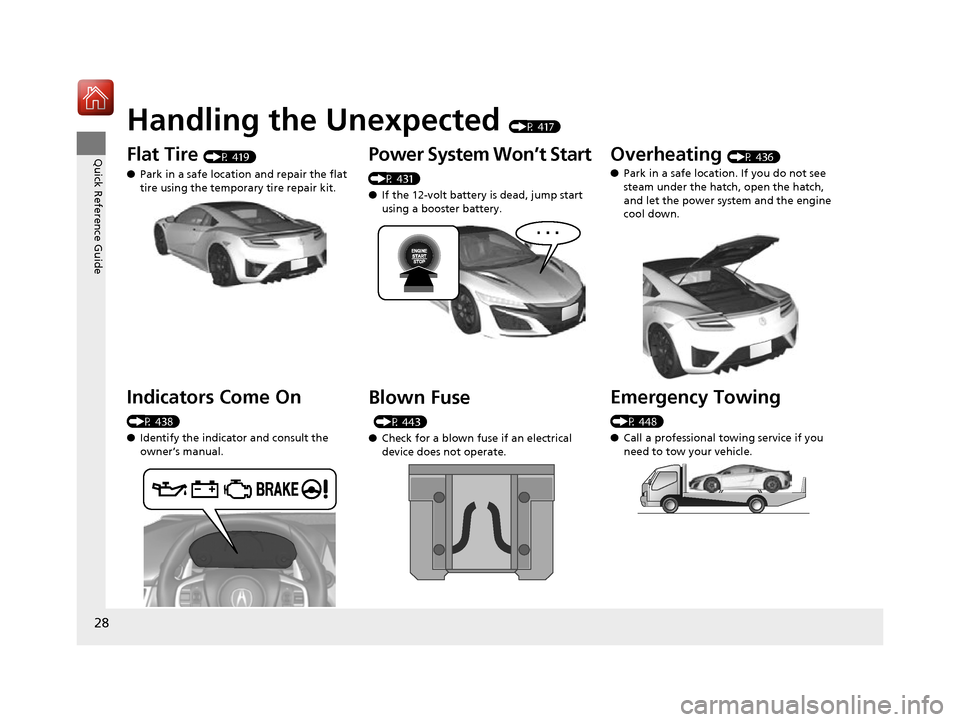
28
Quick Reference Guide
Handling the Unexpected (P 417)
Flat Tire (P 419)
● Park in a safe location and repair the flat
tire using the temporary tire repair kit.
Indicators Come On
(P 438)
●Identify the indicator and consult the
owner’s manual.
Power System Won’t Start
(P 431)
● If the 12-volt battery is dead, jump start
using a booster battery.
Blown Fuse
(P 443)
● Check for a blown fuse if an electrical
device does not operate.
Overheating (P 436)
● Park in a safe location. If you do not see
steam under the hatch, open the hatch,
and let the power sy stem and the engine
cool down.
Emergency Towing
(P 448)
● Call a professional towing service if you
need to tow your vehicle.
17 NSX-31T6N6000.book 28 ページ 2016年4月22日 金曜日 午後3時44分
Page 89 of 473
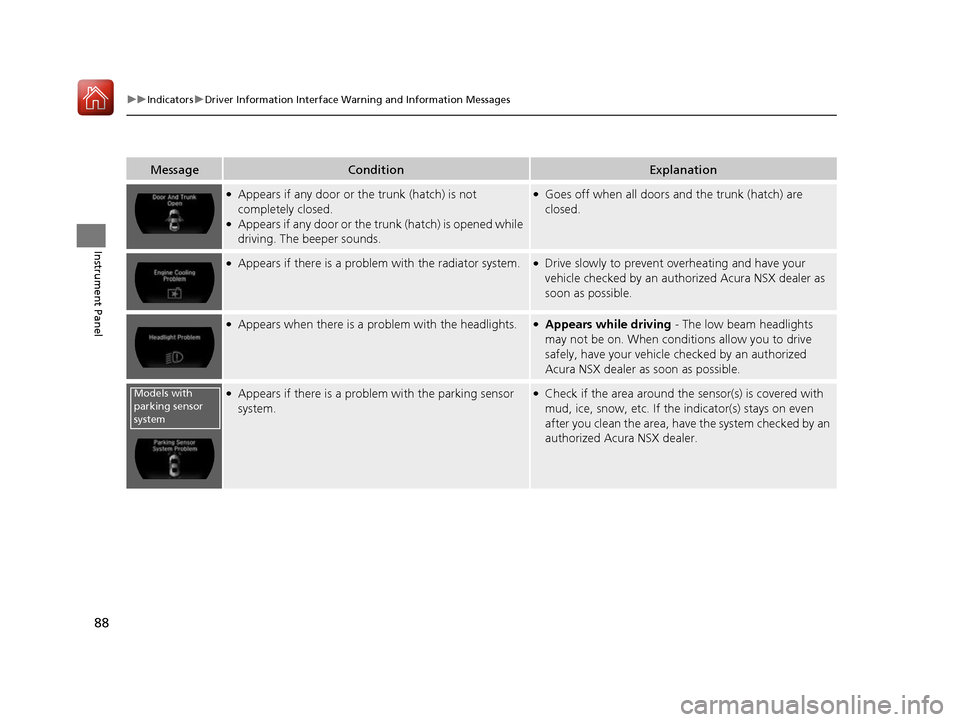
88
uuIndicators uDriver Information Interface Wa rning and Information Messages
Instrument Panel
MessageConditionExplanation
●Appears if any door or the trunk (hatch) is not
completely closed.
●Appears if any door or the trunk (hatch) is opened while
driving. The beeper sounds.
●Goes off when all doors and the trunk (hatch) are
closed.
●Appears if there is a problem with the radiator system.●Drive slowly to prevent overheating and have your
vehicle checked by an author ized Acura NSX dealer as
soon as possible.
●Appears when there is a pr oblem with the headlights.●Appears while driving - The low beam headlights
may not be on. When conditions allow you to drive
safely, have your vehicle checked by an authorized
Acura NSX dealer as soon as possible.
●Appears if there is a problem with the parking sensor
system.●Check if the area around the sensor(s) is covered with
mud, ice, snow, etc. If the indicator(s) stays on even
after you clean the area, have the system checked by an
authorized Acur a NSX dealer.Models with
parking sensor
system
17 NSX-31T6N6000.book 88 ページ 2016年4月22日 金曜日 午後3時44分
Page 92 of 473

91
uuIndicators uDriver Information Interface Wa rning and Information Messages
Continued
Instrument Panel
MessageConditionExplanation
●Appears when the engine is running and indicates that
the engine oil level is low.●Appears while driving - Immediately stop in a safe
place.
2 If the Low Oil Level Symbol Appears P. 442
●Appears when the engine is running and indicates that
there is a problem with the oil level sensor.●Have your vehicle checked by an authorized Acura NSX
dealer as soon as possible.
●Appears if the engine coolant temperature is
abnormally high.
2 Overheating P. 436
●Appears if there is a problem with the fuel system.
Engine performance will be limited.●Immediately stop in a safe place and set the power
mode to VEHICLE OFF (LOCK), then select the ON mode
again.
Have your vehicle checked by an authorized Acura NSX
dealer if the message appears again.
●Appears if there is a temporary problem with the gear
shift mechanism and initialization is necessary.●Depress the brake pedal and shift to (P.
●Appears when the transmission is undergoing
initialization.●Keep the brake pedal depressed.
●Appears when a temporary problem is fixed.●Initialization will be completed when the engine is
restarted.
17 NSX-31T6N6000.book 91 ページ 2016年4月22日 金曜日 午後3時44分
Page 97 of 473
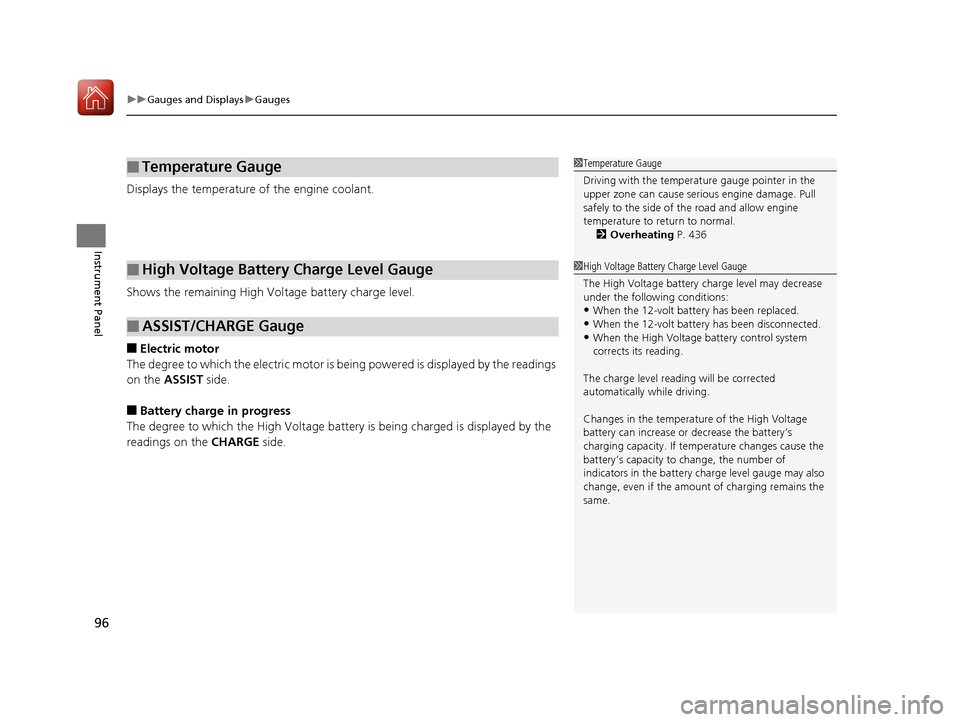
uuGauges and Displays uGauges
96
Instrument Panel
Displays the temperature of the engine coolant.
Shows the remaining High Voltage battery charge level.
■Electric motor
The degree to which the electric motor is be ing powered is displayed by the readings
on the ASSIST side.
■Battery charge in progress
The degree to which the High Voltage battery is being charged is displayed by the
readings on the CHARGE side.
■Temperature Gauge
■High Voltage Battery Charge Level Gauge
■ASSIST/CHARGE Gauge
1Temperature Gauge
Driving with the temperat ure gauge pointer in the
upper zone can cause serious engine damage. Pull
safely to the side of th e road and allow engine
temperature to return to normal. 2 Overheating P. 436
1High Voltage Battery Charge Level Gauge
The High Voltage battery ch arge level may decrease
under the following conditions:
•When the 12-volt batter y has been replaced.
•When the 12-volt battery has been disconnected.
•When the High Voltage battery control system
corrects its reading.
The charge level readin g will be corrected
automatically while driving.
Changes in the temperature of the High Voltage
battery can increase or decrease the battery’s
charging capacity. If temp erature changes cause the
battery’s capacity to change, the number of
indicators in the battery ch arge level gauge may also
change, even if the amount of charging remains the
same.
17 NSX-31T6N6000.book 96 ページ 2016年4月22日 金曜日 午後3時44分
Page 394 of 473

393
Maintenance
Checking and Maintaining Tires
Checking Tires
To safely operate your vehicle, your tires must be of the proper type and size, in
good condition with adequate tread, and properly inflated.
■Inflation guidelines
Properly inflated tires provide the best combination of handling, tread life, and
comfort. Refer to the driver’s doorjamb labe l or specifications page for the specified
pressure.
Underinflated tires wear unev enly, adversely affect handling and fuel economy, and
are more likely to fail from overheating.
Overinflated tires make your vehicle ride ha rshly, are more prone to road hazards,
and wear unevenly.
Every day before you drive, look at each of the tires. If one looks lower than the
others, check the pressure with a tire gauge.
At least once a month or before long trips , use a gauge to measure the pressure in
all tires. Even tires in good condition can lose 1 to 2 psi (10 to 20 kPa, 0.1 to 0.2
kgf/cm
2) per month.
■Inspection guidelines
Every time you check inflation, also examine the tires and valve stems.
Look for:
• Bumps or bulges on the side or in the tread. Replace the tire if you find any cuts,
splits, or cracks in the side of the tire . Replace it if you see fabric or cord.
• Remove any foreign objects and inspect for air leaks.
• Uneven tread wear. Have an authorized Acura NSX dealer check the wheel
alignment.
• Excessive tread wear.
2 Wear Indicators P. 398
•Cracks or other damage around valve stem.
1Checking Tires
Measure the air pressure when tires are cold. This
means the vehicle has been parked for at least three
hours, or driven less than 1 mile (1.6 km). If
necessary, add or releas e air until the specified
pressure is reached.
If checked when hot, tire pressure can be as much as
4 – 6 psi (30 – 40 kPa, 0.3 – 0.4 kgf/cm
2) higher than
if checked when cold.
Have an authorized Acura NSX dealer check the tires
if you feel a consistent vi bration while driving. New
tires and any that have be en removed and reinstalled
should be properly balanced.
3WARNING
Using tires that are excessively worn or
improperly inflated can cause a crash in
which you can be seriously hurt or killed.
Follow all instruction s in this owner’s
manual regarding ti re inflation and
maintenance.
17 NSX-31T6N6000.book 393 ページ 2016年4月22日 金曜日 午後3時44分
Page 418 of 473
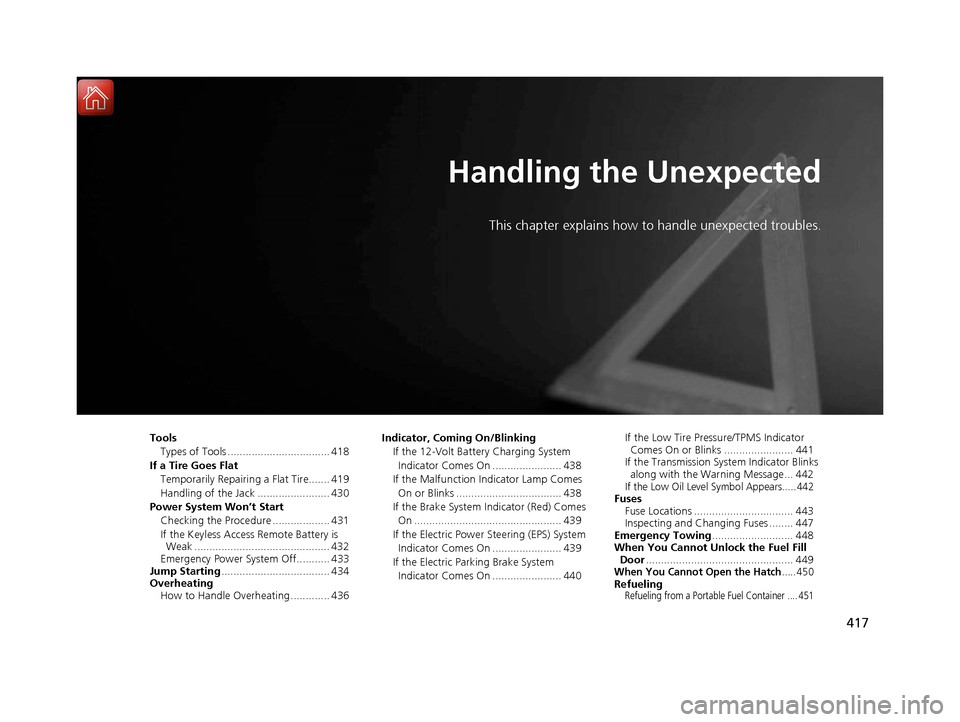
417
Handling the Unexpected
This chapter explains how to handle unexpected troubles.
ToolsTypes of Tools .................................. 418
If a Tire Goes Flat Temporarily Repairi ng a Flat Tire....... 419
Handling of the Jack ........................ 430
Power System Won’t Start Checking the Procedure ................... 431
If the Keyless Access Remote Battery is Weak ............................................. 432
Emergency Power System Off........... 433
Jump Starting .................................... 434
Overheating How to Handle Overheating ............. 436 Indicator, Coming On/Blinking
If the 12-Volt Battery Charging System Indicator Comes On ....................... 438
If the Malfunction Indicator Lamp Comes On or Blinks ................................... 438
If the Brake System Indicator (Red) Comes On ................................................. 439
If the Electric Power Steering (EPS) System Indicator Comes On ....................... 439
If the Electric Parking Brake System Indicator Comes On ....................... 440 If the Low Tire Pressure/TPMS Indicator
Comes On or Blinks ....................... 441
If the Transmission System Indicator Blinks along with the Warning Message... 442
If the Low Oil Level Symbol Appears.....442Fuses Fuse Locations ................................. 443
Inspecting and Changing Fuses ........ 447
Emergency Towing ........................... 448
When You Cannot Unlock the Fuel Fill Door ................................................. 449
When You Cannot Open the Hatch.....450RefuelingRefueling from a Portable Fuel Container .... 451
17 NSX-31T6N6000.book 417 ページ 2016年4月22日 金曜日 午後3時44分
Page 437 of 473
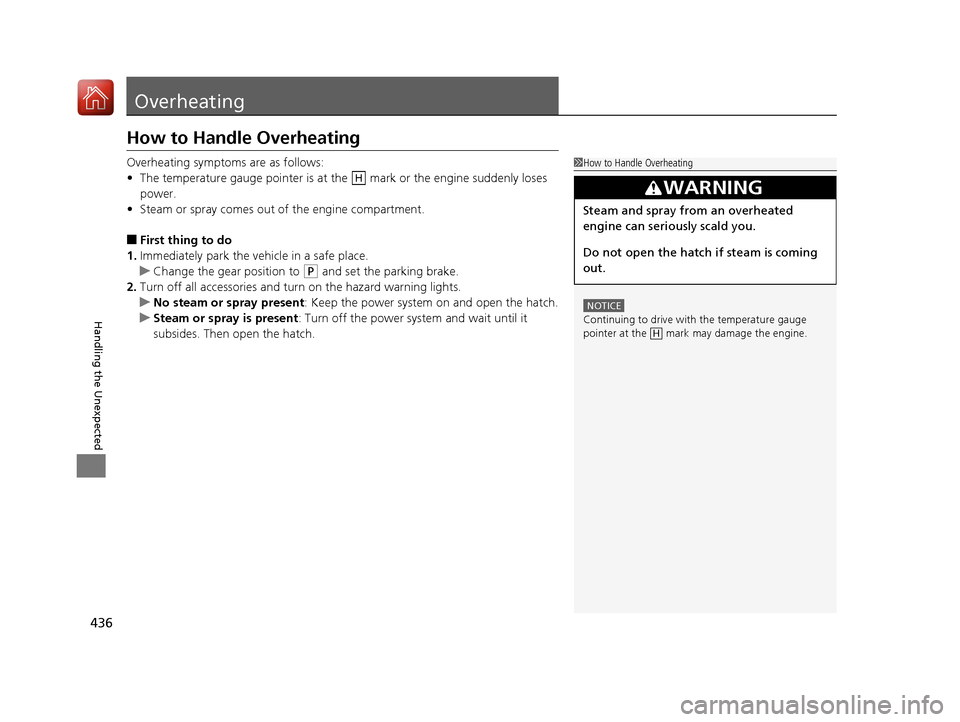
436
Handling the Unexpected
Overheating
How to Handle Overheating
Overheating symptoms are as follows:
•The temperature gauge pointer is at the mark or the engine suddenly loses
power.
• Steam or spray comes out of the engine compartment.
■First thing to do
1. Immediately park the vehicle in a safe place.
u Change the gear position to
(P and set the parking brake.
2. Turn off all accessories and turn on the hazard warning lights.
u No steam or spray present : Keep the power system on and open the hatch.
u Steam or spray is present : Turn off the power system and wait until it
subsides. Then open the hatch.
1 How to Handle Overheating
NOTICE
Continuing to drive with the temperature gauge
pointer at the mark may damage the engine.
3WARNING
Steam and spray from an overheated
engine can seriously scald you.
Do not open the hatch if steam is coming
out.
H
H
17 NSX-31T6N6000.book 436 ページ 2016年4月22日 金曜日 午後3時44分
Page 438 of 473

437
uuOverheating uHow to Handle Overheating
Handling the Unexpected
■Next thing to do
1.Check that the cooling fan is operating and
turn the power system off once the
temperature gauge pointer comes down.
u If the cooling fan is not operating,
immediately turn the power system off.
2. Once the engine has cooled down, inspect
the coolant level and check the cooling
system components for leaks.
2 Checking the Coolant P. 382
uIf the coolant level in the reserve tank is
low, or no coolant in the tank, check that
the radiator is cool. Cover the reserve
tank cap with a heavy cloth and open the
cap. Add coolant until it reaches the
MAX mark, and put the cap back on.
■Last thing to do
Once the engine has cooled sufficiently, turn the power system on and check the
temperature gauge. If the temperature gauge pointer has gone down, resume
driving. If it has not gone down, contact an authorized Acura NSX dealer for repairs.
1How to Handle Overheating
If the coolant is leaking, contact an authorized Acura
NSX dealer for repairs.
Use water as an emergency/temporary measure only.
Have an authorized Acura NSX dealer flush the
system with proper antifree ze as soon as possible.
3WARNING
Removing the reserve tank cap while the
engine is hot can cause the coolant to spray
out, seriously scalding you.
Always let the engine and radiator cool
down before removing the reserve tank
cap.
Engine Coolant
Reserve Tank
MAX
MIN
17 NSX-31T6N6000.book 437 ページ 2016年4月22日 金曜日 午後3時44分
Page 467 of 473
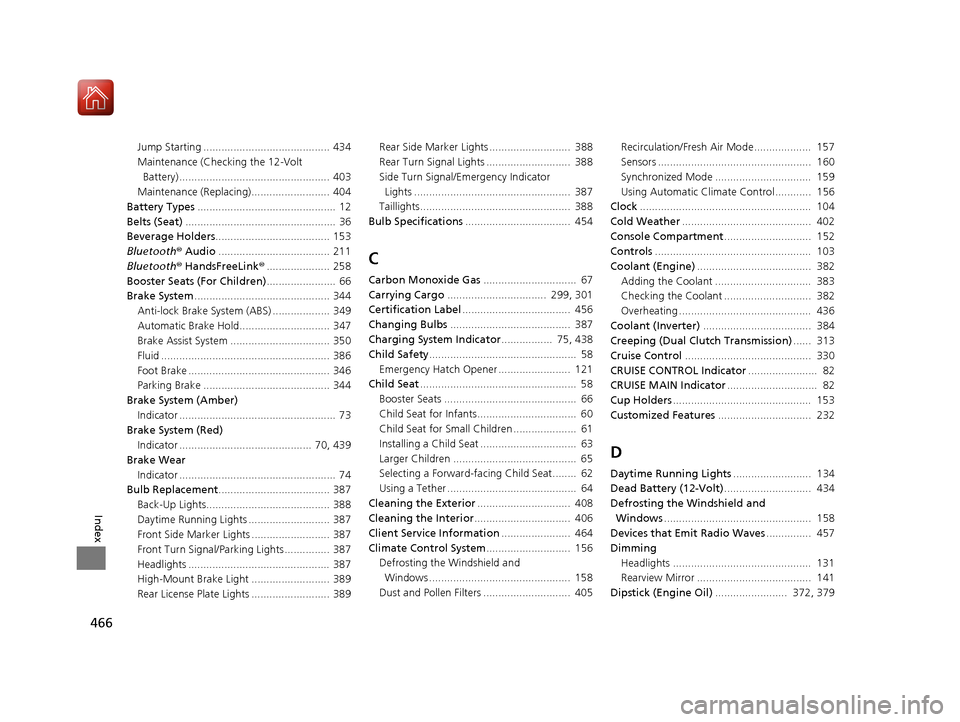
466
Index
Jump Starting .......................................... 434
Maintenance (Checking the 12-Volt Battery) .................................................. 403
Maintenance (Replacing).......................... 404
Battery Types .............................................. 12
Belts (Seat) .................................................. 36
Beverage Holders ...................................... 153
Bluetooth ® Audio ..................................... 211
Bluetooth ® HandsFreeLink ®..................... 258
Booster Seats (For Children) ....................... 66
Brake System ............................................. 344
Anti-lock Brake System (ABS) ................... 349
Automatic Brake Hold.............................. 347
Brake Assist System ................................. 350
Fluid ........................................................ 386
Foot Brake ............................................... 346
Parking Brake .......................................... 344
Brake System (Amber) Indicator .................................................... 73
Brake System (Red) Indicator ............................................ 70, 439
Brake Wear
Indicator .................................................... 74
Bulb Replacement ..................................... 387
Back-Up Lights......................................... 388
Daytime Running Lights ........................... 387
Front Side Marker Lights .......................... 387
Front Turn Signal/Parking Lights ............... 387
Headlights ............................................... 387
High-Mount Brake Light .......................... 389
Rear License Plate Lights .......................... 389 Rear Side Marker Lights ........................... 388
Rear Turn Signal Lights ............................ 388
Side Turn Signal/Emergency Indicator
Lights .................................................... 387
Taillights.................................................. 388
Bulb Specifications ................................... 454
C
Carbon Monoxide Gas ............................... 67
Carrying Cargo ................................. 299, 301
Certification Label .................................... 456
Changing Bulbs ........................................ 387
Charging System Indicator ................. 75, 438
Child Safety ................................................. 58
Emergency Hatch Opener ........................ 121
Child Seat .................................................... 58
Booster Seats ............................................ 66
Child Seat for Infants................................. 60
Child Seat for Small Children ..................... 61
Installing a Child Seat ................................ 63
Larger Children ......................................... 65
Selecting a Forward-facing Child Seat........ 62
Using a Tether ........................................... 64
Cleaning the Exterior ............................... 408
Cleaning the Interior ................................ 406
Client Service Information ....................... 464
Climate Control System ............................ 156
Defrosting the Windshield and Windows ............................................... 158
Dust and Pollen Filters ............................. 405 Recirculation/Fresh Air Mode................... 157
Sensors ................................................... 160
Synchronized Mode ................................ 159
Using Automatic Climate Control............ 156
Clock ......................................................... 104
Cold Weather ........................................... 402
Console Compartment ............................. 152
Controls .................................................... 103
Coolant (Engine) ...................................... 382
Adding the Coolant ................................ 383
Checking the Coolant ............................. 382
Overheating ............................................ 436
Coolant (Inverter) .................................... 384
Creeping (Dual Clutch Transmission) ...... 313
Cruise Control .......................................... 330
CRUISE CONTROL Indicator ....................... 82
CRUISE MAIN Indicator .............................. 82
Cup Holders .............................................. 153
Customized Features ............................... 232
D
Daytime Running Lights .......................... 134
Dead Battery (12-Volt) ............................. 434
Defrosting the Windshield and Windows ................................................. 158
Devices that Emit Radio Waves ............... 457
Dimming Headlights .............................................. 131
Rearview Mirror ...................................... 141
Dipstick (Engine Oil) ........................ 372, 379
17 NSX-31T6N6000.book 466 ページ 2016年4月22日 金曜日 午後3時44分